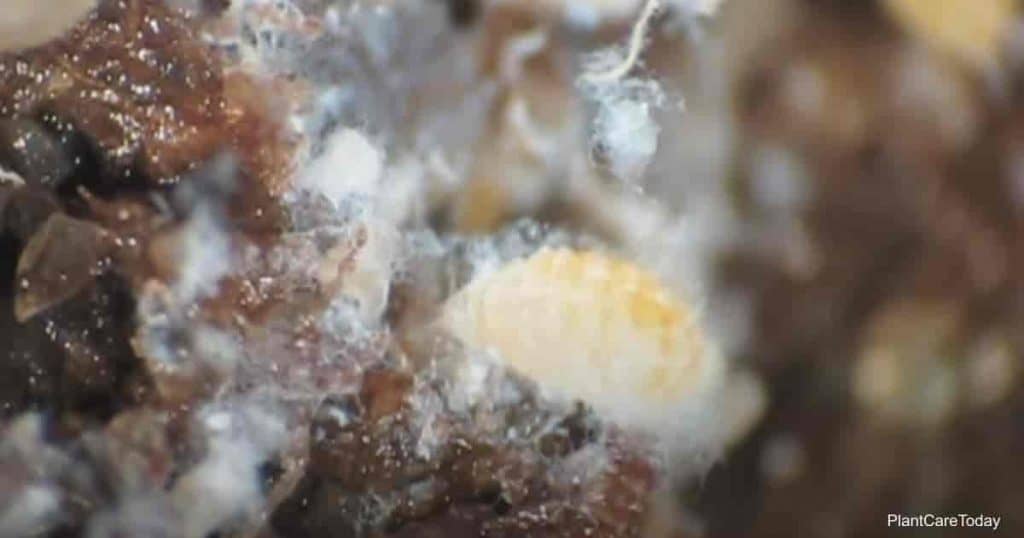When mealy bugs claim a plant as their home, they can cause quite a bit of damage, including killing the plant. Worst of all, they tend to spend time in your plants’ soil, so mealybugs can be tough to get rid of.
Due to this, mealybugs are insect pests plant owners should be aware of.

What Is A Mealybug?
Mealybugs come from the family Pseudococcidae and are found in warm, moist places. They are small, about 1/20″ to ⅕” of an inch in size. They have pink bodies with waxy, white cottony tendrils that cause them to appear fuzzy.
Mealy bugs are often confused with woolly aphids and plant scales thanks to their similar appearance.

These bugs love warm and moist climates and are more likely found in greenhouses. The mealybugs feed on plant sap and secrete a waxy residue that is a surefire sign of their infestation.
You will find little white Mealybugs on the undersides of leaves or near the base of stems. A good sign of mealybug presence is unusual residue on leaves or soil with a cottony white-looking wax. [source]
A molded or yellowing plant can also indicate a soil with mealybug infestation.
What Damage Do Mealybugs Cause?
Root mealybug populations infest soil in nearby plants and lay eggs along the roots. This can prevent the plant from taking enough water to survive. Yellowing leaves and wilting are signs that root mealybugs are present.
In large numbers, mealybugs can kill off a heavily infested plant and can spread across your home or garden to other healthy hosts.

Mealybugs use every part of your plant for their home and living needs. While the warm, wet potting mix is perfect for harboring their eggs, the leaves and stems make for a tasty treat.
Since these bugs are prone to infesting your plant quickly and thoroughly, it’s vital to take action as soon as you know their presence.
How To Control Mealy Bugs In Potting Soil?
There are a few ways to control mealybug pests to save your plant. Natural remedies can work well in small numbers to control infestations. Chemical solutions may be needed for larger numbers of root mealybugs.
The best way to control a mealybug infestation is to move the infected plant away from all your other plants to stop the spread.
Related: Are Soil Mites Bad?
Natural Mealy Bug Control Methods
Soapy Spray: The University of Wisconsin recommends using a soapy spray to eliminate mealybugs. [source]
Mix one gallon of water with two tablespoons of mild dish soap. Spray the insecticidal soap mixture on your plant and in the plant soil. This will deter mealybugs from living in your plant’s space.

Dryout The Potting Mix: Another tip is to dry out the soil. While this may not work for all plants, it can help. Root mealybugs love moisture and will evacuate the plant if there is none present.
Cold Temperature: Moving your plant to a colder space will also deter these insects. If it is cold outside and your plant can withstand the temperatures, you can opt for moving your plant to get rid of these bugs. I would not recommend this option.
Rubbing Alcohol: Dip a Q-tip in rubbing alcohol and swab any visible mealybugs with the solution. The bugs will turn brown and die. They may potentially spread alcohol to other mealybugs in the process.
It’s important to heed caution with this technique, as too much alcohol could hurt the plant.
Chemical Mealybug Control And Treatment
If the mealybug infestation is severe, use natural insecticides like Neem and Diatomaceous Earth. These organic options control unwanted insects and mealybug populations.

- Mix Diatomaceous earth into the soil.
- Use soil drenches of Neem oil on some varieties of plants.
Unfortunately, insecticides can only do so much. Larger infestations may require throwing the plant away to avoid spreading mealybugs to other plants. While this isn’t a pleasant option, sometimes it is necessary.
The best way to deal with mealybugs is to remain vigilant. These insects arrive when purchasing new plants at the garden center or from a nursery.
Inspect new plants’ soil and root systems before adding them to your collection. Check for the cottony wax residue of soil mealybugs or the bugs themselves.
If you find these pests in your new houseplants, use the above methods to get rid of mealybugs in the soil before introducing the new plant in your space.